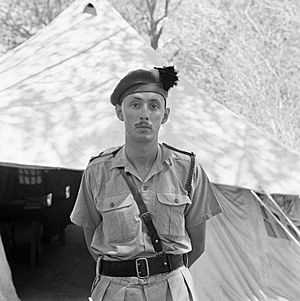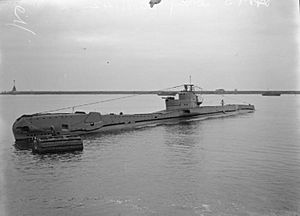Operation Flipper facts for kids
Quick facts for kids Operation Flipper or the 'Rommel Raid' |
|||||||
|---|---|---|---|---|---|---|---|
| Part of Operation Crusader during the Second World War | |||||||
 Geoffrey Keyes VC |
|||||||
|
|||||||
| Belligerents | |||||||
| Commanders and leaders | |||||||
| Robert Laycock Geoffrey Keyes (DOW) |
Erwin Rommel Alfredo Mercuro |
||||||
| Casualties and losses | |||||||
| 2 killed 28 captured (incl. 3 wounded) 3 escaped |
4 killed 3 wounded |
||||||
Operation Flipper (also known as the Rommel Raid) was a secret British commando mission during World War II. It involved soldiers from No. 11 (Scottish) Commando. The main goal was to attack the headquarters of Erwin Rommel. He was a famous German general leading the Panzergruppe Afrika in North Africa.
The raid happened on the night of 17/18 November 1941. This was just before a big British attack called Operation Crusader. But the mission failed because Rommel had moved his headquarters weeks earlier. Most of the commandos who landed were killed or captured. Only a few managed to escape.
Contents
Planning the Secret Mission
From October to November 1941, the British Eighth Army planned this special mission. They wanted to attack several important enemy locations:
- Rommel's supposed headquarters near Beda Littoria. This was about 18 miles (29 km) inland.
- A radio station and intelligence center at Apollonia.
- An Italian headquarters and communication cables at Cyrene.
- The headquarters of the Italian Trieste Division near Slonta.
The main aim of the raid was to capture or kill General Rommel. This would confuse the German forces before Operation Crusader began. British intelligence believed Rommel's headquarters was at Beda Littoria. This was because a spy named Captain John Haselden had seen Rommel's staff car there.
Lieutenant-Colonel Robert Laycock led the operation. Lieutenant-Colonel Geoffrey Keyes chose to lead the most dangerous part: the attack on Rommel's headquarters. However, the British planners did not know that Rommel had already moved his headquarters. He had moved closer to Tobruk to be near the fighting. Rommel was not even in North Africa during the raid. He was in Rome asking for new supply ships.
The Raid Begins
Landing the Commandos (10–15 November)
On 10 November, the submarine HMS Torbay carried Keyes and 26 men. Another submarine, HMS Talisman, carried Laycock and 26 men from Alexandria. On the night of 14/15 November 1941, Keyes' group landed on a beach called Khashm al-Kalb. Two-man teams from the Special Boat Section (SBS) guided them using folding canoes. This beach was about 250 miles (400 km) behind enemy lines. Once ashore, they met with Captain Haselden, who had arrived earlier.
The weather got much worse, making it hard for Laycock's group to land. Laycock and seven men made it ashore, but the rest were stuck on the Talisman. With only 34 of the 59 planned men, they had to change their plans. Laycock stayed at the beach with three men to keep it safe. Keyes led his 25 men to attack Rommel's supposed headquarters. Lieutenant Cooke took six men to destroy communication sites near Cyrene. Haselden's group finished their mission and was picked up by the Long Range Desert Group.
The Attack and Retreat (15–18 November)
Keyes' men hid in a dry riverbed until dark. Then they began their difficult journey. Their Arab guide refused to go with them because of the bad weather. Keyes led his men on a tough climb of 1,800 feet (550 m). They then marched 18 miles (29 km) in total darkness and heavy rain. They hid in a cave during the day. By 10:00 PM on the third night, they were just a few hundred yards from their target.
At 11:59 PM, Keyes led his team past guards to the house. They couldn't find an open window or door. So, Captain Robin Campbell, who spoke excellent German, knocked on the front door. He demanded to be let in. When a guard opened the door, Campbell shot him. Keyes was then shot by a German soldier inside the house. He died quickly after being taken outside.
Soon after, Campbell was accidentally shot in the leg by one of his own men. He gave command to Sergeant Jack Terry. Terry gathered the remaining 17 men and retreated to rejoin Laycock at the beach. Meanwhile, Lieutenant Cooke's men met Italian police paratroopers. The Italians had been looking for the British raiders near the village of Mansura.
Capture and Escape (19 November)
On 19 November, Italian paratroopers found what they thought was a group of Arabs. When called upon, the group fired back. The Italians realized they were British commandos. The British retreated into a cave. With no way out, the wounded commandos surrendered. The Italians captured an officer, a non-commissioned officer, and three other soldiers. All but the officer were wounded and received medical care from the Italians. The Italians found weapons and explosives in the cave. Three Italians were wounded in the fight.
It was impossible for Laycock's group to get back on the submarines because of the bad weather. They were discovered and fought with Italian police and German troops. Knowing they couldn't fight a larger force, Laycock ordered his men to scatter. Laycock and Terry managed to escape after 37 days in the desert. Bombardier John Brittlebank, one of the SBS team, also escaped. He survived alone in the desert for 40 days until Allied troops found him. The rest of the raiding force was captured. Only Keyes was killed by the Germans. One man had drowned during the landing.
After the Raid
On 17 November 1941, the day of the raid, Rommel was in Italy. British intelligence knew this through secret messages. An urgent message was sent to stop the operation, but it was too late.
Some historians suggest that Rommel was not the main target of the raid. His name was not in the official plan. Also, there is no clear proof that the spy, Haselden, reported Rommel's presence at the house. It's also unclear how the commandos would have recognized Rommel. However, one soldier, Gunner Jim Gornall, said that Keyes told them their goal was to "get Rommel." When Rommel heard about the raid, he was surprised. He preferred to be near the front lines with his troops, not 250 miles (400 km) behind them.
What Happened to the Soldiers
The British had two men killed and 28 captured (three of whom were wounded). Three men escaped. The Germans had four killed and three wounded. Rommel ordered that Keyes' body and the four dead Germans be buried with military honors.
Keyes was given the Victoria Cross after he died. This is the highest award for bravery in the British military. Sergeant Jack Terry received the Distinguished Conduct Medal (DCM). Bombardier John Brittlebank (SBS) also received the DCM for his actions. Gunner Jim Gornall was awarded the Military Medal (MM).
See also
- List of British military equipment of World War II
- List of German military equipment of World War II
- List of Italian military equipment in World War II


